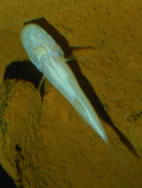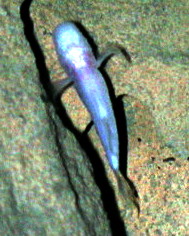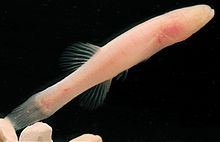The northern cavefish or northern blindfish, Amblyopsis spelaea, is found in caves through Kentucky and southern Indiana. It is listed as a threatened species in the United States and the IUCN lists the species as near threatened.

The Mexican tetra, also known as the blind cave fish, blind cave characin, and blind cave tetra, is a freshwater fish of the family Characidae of the order Characiformes. The type species of its genus, it is native to the Nearctic realm, originating in the lower Rio Grande and the Neueces and Pecos Rivers in Texas, as well as the central and eastern parts of Mexico.

The Amblyopsidae are a fish family commonly referred to as cavefish, blindfish, or swampfish. They are small freshwater fish found in the dark environments of caves, springs and swamps in the eastern half of the United States. Like other troglobites, most amblyopsids exhibit adaptations to these dark environments, including the lack of functional eyes and the absence of pigmentation. More than 200 species of cavefishes are known, but only six of these are in the family Amblyopsidae. One of these, Forbesichthys agassizii, spends time both underground and aboveground. A seventh species in this family, Chologaster cornuta, is not a cave-dweller but lives in aboveground swamps.

The Ozark cavefish, Amblyopsis rosae, is a small subterranean freshwater fish endemic to the United States. It has been listed as a threatened species in the US since 1984; the IUCN lists the species as Near Threatened. It is listed as endangered by the Missouri Department of Conservation.

The Alabama cavefish is a critically endangered species of amblyopsid cavefish found only in underground pools in Key Cave, located in northwestern Alabama, United States in the Key Cave National Wildlife Refuge. It was discovered underneath a colony of gray bats in 1967 by researchers Robert A. Kuehne and John E. Cooper and scientifically described in 1974.
The spring cavefish is the only member of the genus Forbesichthys and is one of seven species in the family Amblyopsidae. This species is listed as state endangered in Missouri, but it is considered to be of least concern by the IUCN Red List due to its relatively large population size and number of subpopulations. The spring cavefish inhabits caves, springs, spring runs, and spring seeps. It is subterranean, emerging at dusk and retreating underground an hour or two before dawn. The species is located within areas of the central and southeastern United States. It stays underground after dawn, but then emerges into surface waters at dusk. They are a carnivorous fish and are well adapted to their environment. The species' breeding behavior is rarely documented. Spawning occurs underground and in darkness between January and April. The status and distribution of cave-obligate species is incomplete or lacking entirely, which makes conservation and management decisions difficult. Kentucky and Missouri are the two main states that have their agencies managing this species in some way.
Caecobarbus geertsi, the African blind barb or Congo blind barb, is a species of cyprinid fish. This threatened cavefish is only known from Democratic Republic of the Congo, and it is the only member of the monotypic genus Caecobarbus. George Albert Boulenger described this fish in 1921 and it apparently lacks any close relatives in the Congo region.

The waterfall climbing cave fish, also known as the cave angel fish, is a species of troglobitic hillstream loach endemic to Thailand. It reaches a length of 2.8 centimetres (1.1 in) SL. This fish is known for its fins, which can grapple onto terrain, and its ability to climb. This fish is the only known member of its genus. The species has been recorded from eight subterranean sites within a large karst system in Mae Hong Son Province, Thailand. The species has an extent of occurrence of nearly 200 km2, but an area of occupancy of 6 km2; the connectivity of this karst systems is unknown, some caves are definitely connected. The species is found in eight of the caves. It has been recorded from the Susa and Tham Mae Lana. It may also occur in other submerged caves in the area. However, the species has a potential threat of agricultural pollution which could impact the whole karst system, making it one location.
Garra typhlops, also known as the Iran cave barb is a species of ray-finned fish in the family Cyprinidae. It is endemic to caves in Iran. Like other cave-adapted fish, it is blind and lacks pigmentation.

The blind cave eel is a species of fish in the family Synbranchidae. It is endemic to subterranean waters in the Cape Range, Australia. Like other cavefish such as Milyeringa, the blind cave eel is entirely blind and lacks pigmentation. It is listed as vulnerable under the Australian Environment Protection and Biodiversity Conservation Act 1999. Reaching a length of 40 cm (16 in), it is the longest known cavefish.

Typhleotris madagascariensis is a species of fish in the family Milyeringidae that is endemic to Madagascar, where it is only known from underground waters in the southwestern portion of the island. This cavefish is blind and lacks pigmentation, and can reach a standard length of 8 cm (3.1 in).

Typhlichthys subterraneus, the southern cavefish, is a species of cavefish in the family Amblyopsidae endemic to karst regions of the eastern United States.

Cavefish or cave fish is a generic term for fresh and brackish water fish adapted to life in caves and other underground habitats. Related terms are subterranean fish, troglomorphic fish, troglobitic fish, stygobitic fish, phreatic fish and hypogean fish.
Genetypes is a taxonomic concept proposed in 2010 to describe any genetic sequences from type specimens. This nomenclature integrates molecular systematics and terms used in biological taxonomy. This nomenclature is designed to label, or flag, genetic sequences that were sampled from type specimens. The nomenclature of genetypes proposes that genetic sequences from a holotype should be referred to as a “hologenetype”, sequences from a topotype should be a “topogenetype”, and so forth. In addition, the genetic marker(s) used should be incorporated into the nomenclature.
Kryptoglanis shajii is a species of subterranean catfish found in subsurface waters in the Western Ghats in Kerala, India. This cavefish grows to a length of 5.9 centimetres (2.3 in) SL. It is currently the only known member of its genus and family. Although first discovered from underground waters, it has also been seen in dense vegetation in paddy fields and was found to be common in this habitat in the Chalakudy. The species strongly avoids light and feeds on small invertebrates.

Amblyopsis is a genus of small fish in the family Amblyopsidae that are endemic to the central and eastern United States. Like other cavefish, they lack pigmentation and are blind. The most recently described species was in 2014. Uniquely among fish, Amblyopsis brood their eggs in the gill chambers. It was formerly incorrectly speculated that the same brooding behavior existed in other genera in the family and in the pirate perch.
Typhleotris mararybe is a critically endangered species of fish in the family Milyeringidae, the blind cave gobies. It is a troglobitic species endemic to cave habitat in southwestern Madagascar. It is unique among known cave-dwelling fish in that is both blind and darkly pigmented. It has well-developed nonvisual sensory systems and dives to avoid approaching objects. The fish was first collected in 2008 and was described to science as a new species in 2012.

Biospeleology, also known as cave biology, is a branch of biology dedicated to the study of organisms that live in caves and are collectively referred to as troglofauna.

Prosanta Chakrabarty is an American ichthyologist and associate professor of ichthyology, evolution and systematics at Louisiana State University. He studied at McGill University where he received a bachelor of science in Applied Zoology and at the University of Michigan where he obtained his PhD in Ecology and Evolution.Among other professional positions he was the Program Director for the National Science Foundation and is currently the Secretary of the American Society of Ichthyologist and Herpetologist. He was named a TED Fellow in 2016, and a TED Senior Fellow in 2018. He was named an Elected Fellow of the AAAS for "distinguished contributions to evolutionary biology, focusing on the bioluminescent systems and historical biogeography of freshwater fishes, and for effectively communicating science to the public."

Chaetobranchini is a tribe of the subfamily Cichlinae, the American cichlids. They are distributed from the river basin of the Orinoco and the Guianas south to the basins of the Río Paraná and Río Paraguay. The two recognised genera of the Chaetobranchini have been classified together with Astronotus in the subfamily Astronotinae but the consensus is that this genus forms the monogeneric tribe, the Astronotini, these two each being one of the seven tribes in Cichlinae.













